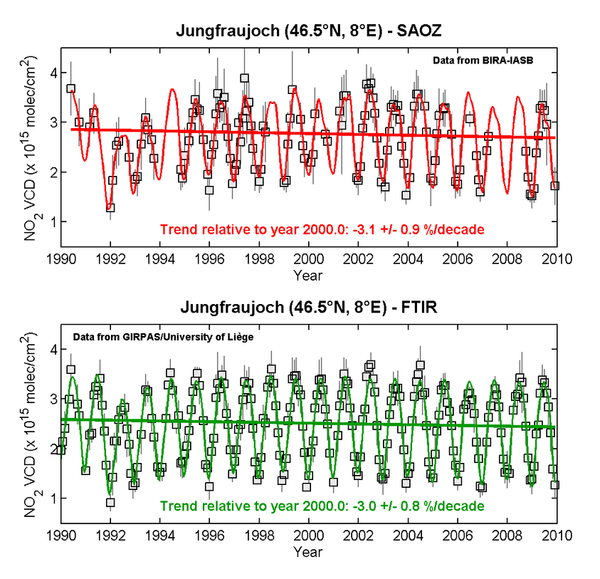|
~
|
Nitrogen dioxide (NO2) plays an important role in controlling ozone abundances in the stratosphere, either directly through the NOx (NO+NO2) catalytic destruction cycle, or indirectly by converting active chlorine, bromine, and hydrogen into their reservoir forms, reducing their availability for ozone-destroying catalytic cycles. The primary source of NOx is the oxidation of nitrous oxide (N2O) in the middle stratosphere which is an important greenhouse gas. The long-term observation of stratospheric NO2 is therefore a central task for monitoring stratospheric ozone and indirectly climate change. Part of the stratospheric NO2 monitoring effort is performed by the UV-vis DOAS Group of the BIRA-IASB at the International High Latitude Research Station of Jungfraujoch in the Swiss Alps (46.5°N, 8.0°E; 3580 m altitude). A ground-based UV-visible SAOZ (Système d′Analyse par Observation Zénithale) spectrometer which measures the stratospheric NO2 vertical column density (VCD) has been operating there since the early nineties in the framework of the Network for the Detection of Atmospheric Composition Change (NDACC). More than two decades of observational data allow us to carry out a thorough study on the long-term evolution of the stratospheric NO2. By using a multiple linear regression model including the most important geophysical forcings (solar cycle, quasi-biennal oscillation (QBO), and the aerosol loading change due to the Mount Pinatubo eruption), a negative trend of about -3%/decade is derived for the 1990-2009 period. A similar trend value is also found when applying the regression model to coincident FTIR observations performed by the GIRPAS Group of the University of Liège. Collocated satellite observations of the ozone column as well as 3D-Chemical Transport Model simulations show that this decline of the NO2 stratospheric column can be at least partly explained by the absence of a positive trend of N2O in the altitude range of the maximum of NO2 concentration and by a slightly positive trend of stratospheric ozone over the 1990-2009 period.
Contact For more information, please contact : François Hendrick |




